Dinosaurs
Advertisement
Dinosaurs Scientific Classification
- Kingdom
- Animalia
Read our Complete Guide to Classification of Animals.
Dinosaurs Conservation Status

Dinosaurs Facts
View all of the Dinosaurs images!
Dinosaurs lived throughout the Mesozoic era, starting 245 million years ago.
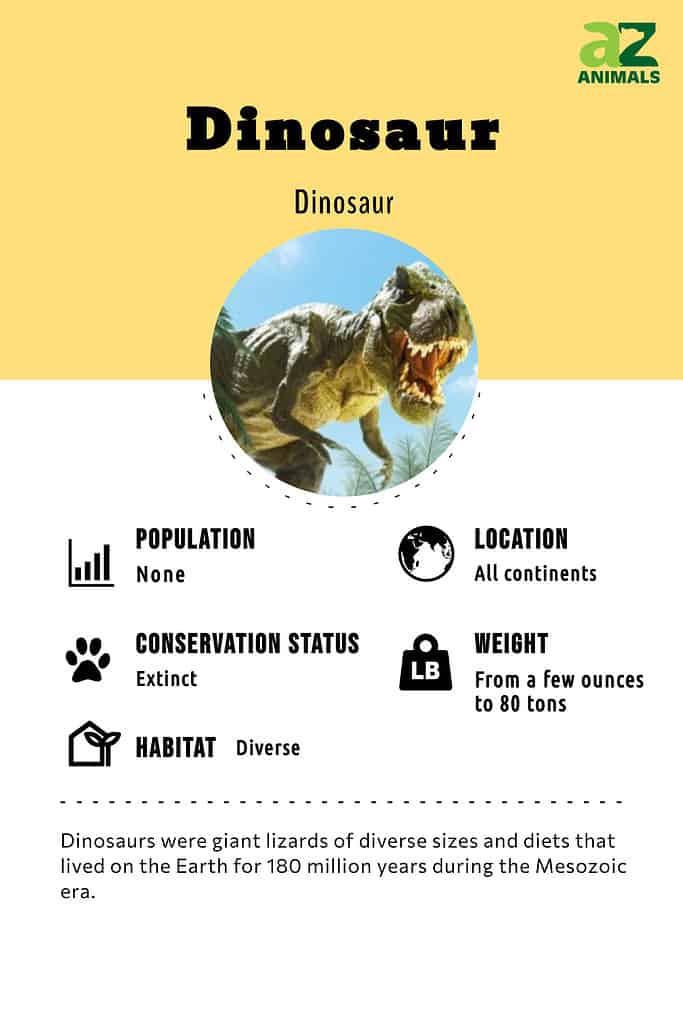
Introduction
Dinosaurs are a large, extinct group of reptiles that lived during the Mesozoic era, starting roughly 245 million years ago. They lasted about 180 million years through the Triassic, Jurassic, and Cretaceous periods. The large variations among the dinosaurs allowed them to survive Earth’s harsh environments when all the continents were still together. It is possible that they experienced continental drifting before they mysteriously disappeared 65-66 million years ago.
Description and Size

Dinosaurs were all vertebrates with textured skin, and they are grouped into avian dinosaurs and non-avian dinosaurs.
©Orla/Shutterstock.com
These creatures ranged in size. The smallest, Oculudentavis, was just half an inch and weighed less than an ounce. Scientists are still debating whether it was a bird or a lizard. The largest dinosaur might have been the Argentinosaurus that was 98-115 feet in length and weighed 66-83 tons. Another contender is the titanosaur Patagotitan mayorum reaching 122 feet in length and weighed 70 tons.
This diverse group was all vertebrates with textured skin. Classification divides them into avian dinosaurs and non-avian dinosaurs. The avian variety are those that possess wings and fly, and all others are non-avian.
Dinosaurs ranged in size, appearance, and habits depending on the species. There have been over 700 valid species of dinosaur discovered so far.
Diet
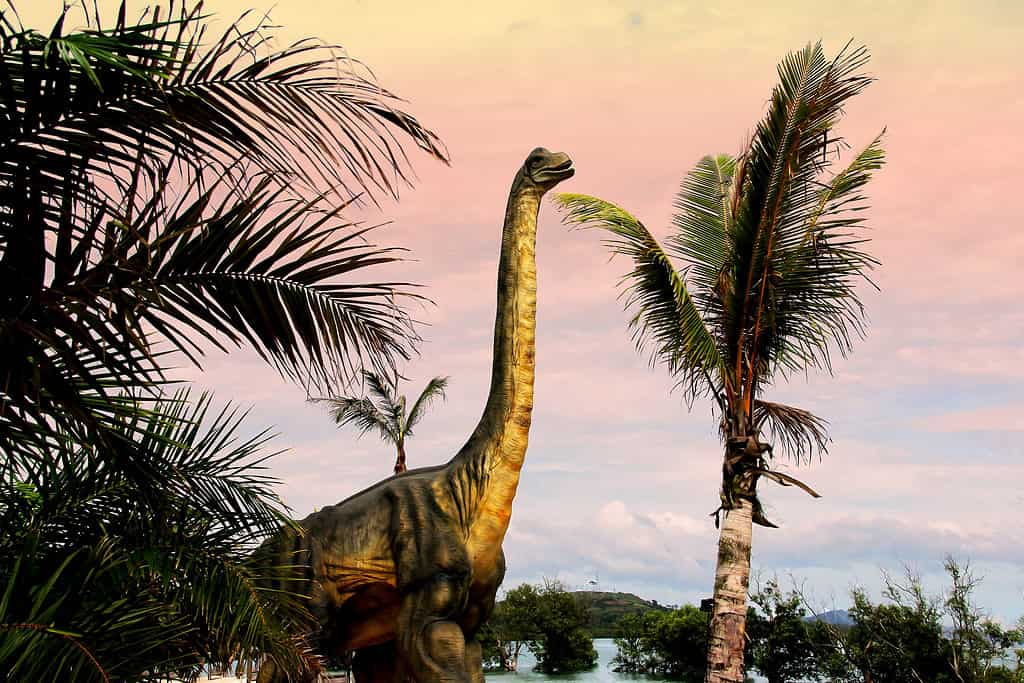
Sauropods, on of the best-known types of dinosaurs were herbivores characterized by long tails, long necks, and small heads.
©thaloengsak/Shutterstock.com
Dinosaurs were classified as either carnivores, herbivores, or omnivores. Those such as the T-Rex were carnivores and likely preyed on other dinosaurs as a meal. Others like the Brachiosaurus was an herbivore that lived off vegetation.
Some ate both plants and meat in their diet because their digestive tract could digest both types of foods and absorb the nutrients. Herbivores likely ate twigs and seeds from plants to grind down on the material for better digestion due to their flat teeth.
Their diverse diet is species specific and scientist determine it based on teeth structures. Carnivores had large and defined canines, whereas herbivores have flat, squared-off teeth. Omnivores have a mixture of both, but the canines were less defined than carnivorous dinosaurs.
Habitat
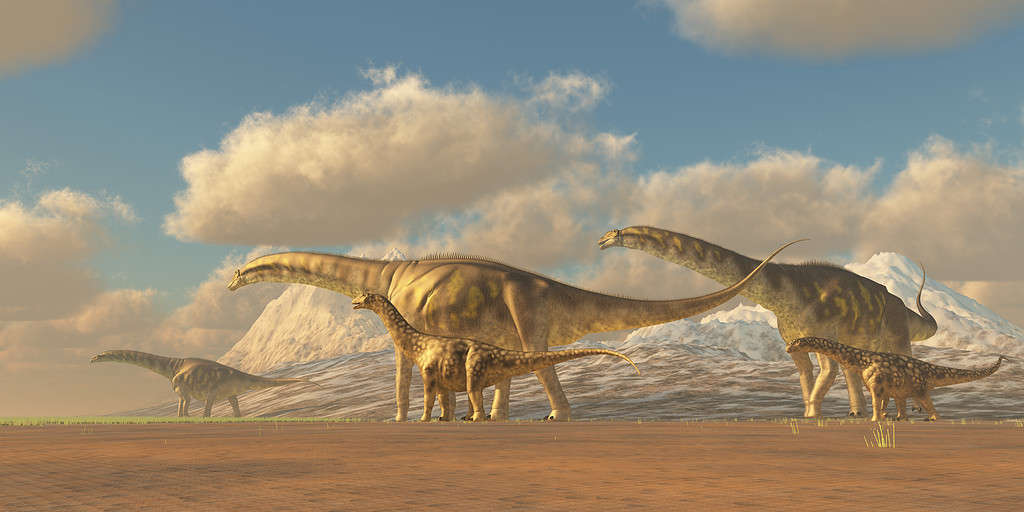
A herd of Argentinosaurus, possibly the largest of the dinosaurs, walks towards more fertile vegetation to eat and water to drink.
©Catmando/Shutterstock.com
Dinosaurs inhabited all of the continents during the Triassic Period of the Mesozoic Era 230 million years ago. The continents were still together during this time. Their fossils have also been found throughout the world. This indicates they roamed the entire Earth; however, some species were more plentiful in certain areas than others.
All the continents were arranged into one supercontinent known as Pangea. It slowly broke apart after dinosaurs had been inhabiting it for 165 million years. The habitat ranged from dry desert lands, where the Troodon and Allosaurus dinosaurs lived, to the forests and richly vegetated areas where dinosaurs like th Lambeosaurus lived.
Others, such as the Plesiosaurs, lived in the ocean. There were both terrestrial and aquatic species that roamed the various forests, deserts, and oceans of the world.
Threats And Predators
A dinosaur’s main threat was other dinosaurs, lack of food and resources, along with natural disasters. Some had a predatory nature and would hunt other dinosaurs for food, whereas some species would consume vegetation and rely on the surrounding environment to provide food from them. If too many carnivores were in one area, their food sources would quickly deplete faster than their prey could reproduce.
Discoveries and Fossils
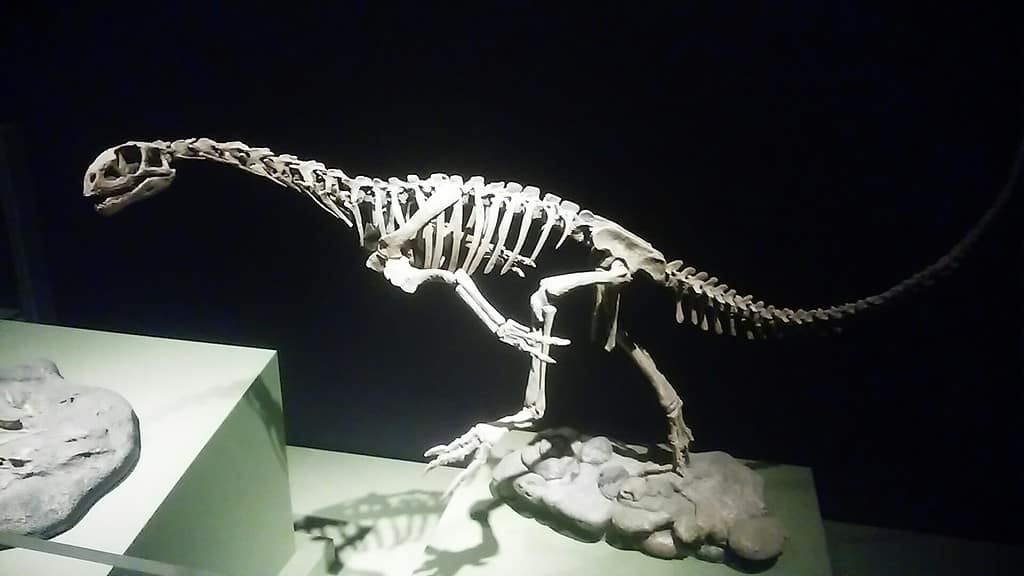
Chilesaurus diegosuarezi dinosaur skeleton.
©ケラトプスユウタ, CC BY-SA 4.0 via Wikimedia Commons – License
The first dinosaur fossil was discovered in England in 1676 by Robert Plot. It was called the Megalosaurus. The fossil was not given a name until scientists started studying it in the 1820s. It was named by William Buckland.
Over the years, paleontologists and scientists have been discovering plenty of well-preserved fossils that give us better insight into how these creatures lived and looked. So far, paleontologists have discovered over 700 different dinosaur species; however, there are believed to be many more awaiting discovery.
Extinction
Dinosaurs went extinct 65 million years ago at the end of the Cretaceous Period after roaming the earth for 165 million years. The reason behind their extinction is still a mystery, but scientists have formed various scenarios that could be the reason for their extinction, such as an asteroid strike known as the Paleogene mass extinction. Other theories include weakened ecosystems, continental drift, carbon or sulfur dioxide poisoning, or perhaps extreme climate change.
The most agreed-upon theory is the asteroid impact that caused the catastrophic global impact. The asteroid could have affected the earth’s climate as one of its long-term effects.
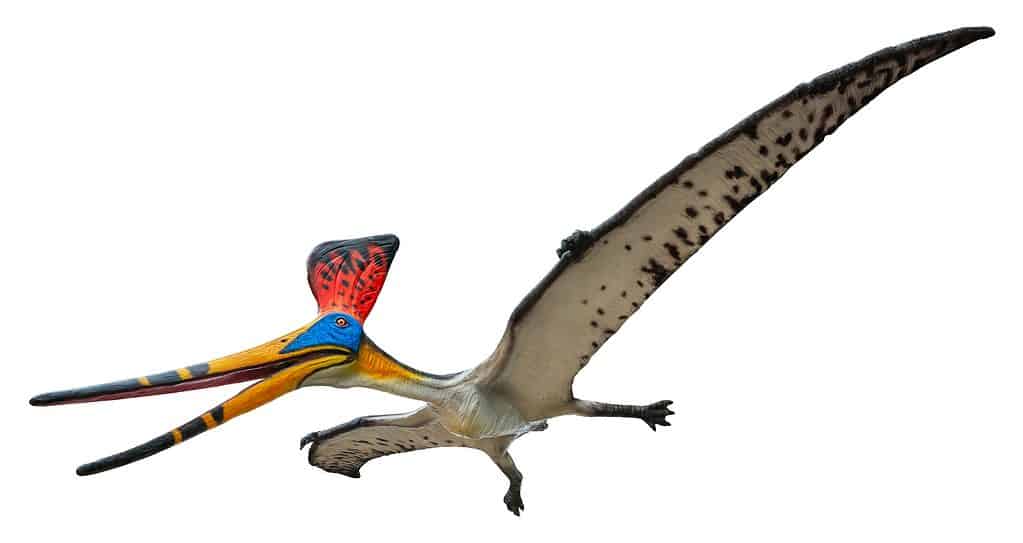
An avian dinosaur, Pteranodon, was one of the largest flying dinosaurs. It lived in mid-America during the Late Cretaceous period.
©YuRi Photolife/Shutterstock.com
Similar Animals
Surprisingly, there are still some animals that roam the earth today that are either closely related to dinosaurs or have a striking resemblance. The similarities are from the shared DNA and similar bone structure as discovered by scientists and researchers.
These are similar animals to the dinosaur:
- Chickens- Both dinosaurs and chickens share similar DNA along with a similar bone structure.
- Crocodiles- They come from the same ancestor as dinosaurs, which are reptiles.
- Turtles- Scientists believed turtles coexisted with dinosaurs.
- Lizards- Both dinosaurs and lizards are reptiles with four limbs, lay eggs, and live on land.
- Sharks- The megalodon was a prehistoric shark that likely lived with dinosaurs and is a descendant of modern sharks.
Dinosaurs FAQs (Frequently Asked Questions)
When were dinosaurs alive?
Dinosaurs were alive 230 million years ago during the late Triassic Period of the Mesozoic Era.
How big were dinosaurs?
Dinosaurs ranged in size from as small as 17.5 inches to as large as 120 feet depending on the species of dinosaur. The smallest dinosaur was the Epidexipteryx hui and the largest was the Argentinosaurus.
Thank you for reading! Have some feedback for us? Contact the AZ Animals editorial team.
Sources
- Wikipedia , Available here: https://en.wikipedia.org/wiki/Dinosaur
- Student share , Available here: https://studentshare.org/biology/1459178-dinosaurs-in-science
- Science focus , Available here: https://www.sciencefocus.com/nature/dinosaurs/
















